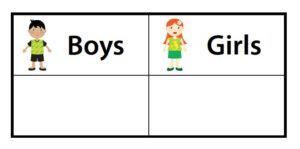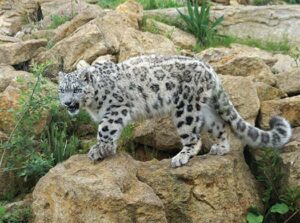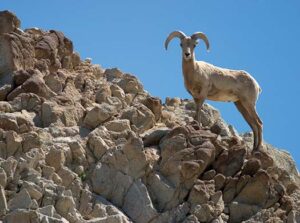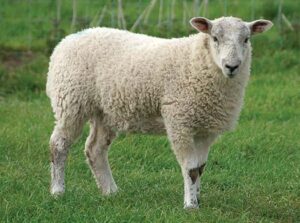Oral language, Letter knowledge
Children will strengthen their comprehension of information presented in a book read aloud and increase the number of novel words they understand. Children will also identify and name the letter J.


New:
4–6 words (see Be Prepared)
Review:
Be Prepared: This is the second of three repeated readings of a book with children. Today’s session focuses on children’s comprehension of information presented in the book, especially connections to children’s experiences. The session also helps children understand more novel words. From the list of novel words you identified prior to your first reading of the book, select 4–6 words to define for children today. Remember, it is okay to select words that a few children may know if you anticipate most children do not understand the word’s meaning. See the Language/Literacy section of the ELM User Guide: 3–5 Years for additional information on how to select and define novel words.
 [Display letter J card.]
[Display letter J card.]
What is the name of this letter?
[Point to the uppercase letter J on the letter card.]
Am I pointing to the uppercase or to the lowercase letter J?
Now let’s spend some time with our book.
[See Week 3, Day 3 of Language/Literacy for a description and examples of how to approach today’s book reading. Key aspects are summarized below:
Number knowledge
Children will understand how to add and subtract.


Review:

Be Prepared: Organize a simple, two-column chart as shown. Include a cutout of a boy and a cutout of a girl.
We are learning about adding and subtracting. What happens to a group when we add more items? (it gets larger) What happens to a group when we subtract items? (it gets smaller)
[Display prepared chart and point to its parts as you describe them.]

Today we will use a chart to help us find out how many children are in a group. We will count how many boys and girls are in a group. Then we will add to see how many children we have all together in our group.
Please come to the chart and put a mark under boy or girl when I call your name.
[Invite five boys and two girls to the chart. One at a time, invite children to put a tally mark under boy or girl. Invite children to have a seat.]
Let’s count the number of boys in our boy group, and then I will write the total number of boys on our chart.
[Lead children in counting the tally marks for boys by touching each mark as you count. Write below the tally marks the numeral that represents the number of tally marks in the “boys” section.]
Now let’s count the number of girls in our group.
[Lead children in counting the tally marks for girls by touching each mark as you count. Write below the tally marks the numeral that represents the number of tally marks in the “girls” section.]
We have five boys in our boy group and two girls in our girl group.
How can we find out how many boys and girls we have all together? (add together the number of boys and the number of girls)
We can add by counting on. Let’s start with the largest group. The boy group has five. Five is larger than two. Let’s count on as we begin with the boy group: 5, 6, 7.
[Point to each tally mark as you count on.]
How many children do we have all together? (seven)
[Invite the same five boys and two girls to the chart.]
Let’s subtract two boys from our group of seven children.
[Encourage two boys to have a seat.]
Two boys from our group sat down. Let’s erase two marks from our chart because we subtracted two boys from our group.
[Erase two tally marks from the chart.]
How can we find out how many children we have remaining in our group? (we can count the number of children, we can count the number of tally marks)
[Lead children in counting as you point to and count the number of tally marks remaining on the chart.]
We started with seven children in our group. We subtracted two boys. Now we have five children left in our group.
Today we added and subtracted to find out how many children were in a group.
Extra support
Enrichment
Invite children to go “subtraction bowling.” Place 10 paper cups on the floor. Invite children to roll a small ball to knock down the cups. Then determine the number of cups left standing.
Determine the number of cats and dogs in children’s families. Ask children the number of dogs and cats in their families and add the totals together to find out how many pets are in the entire group. Example: “We have two cats and three dogs in our group. How many pets do we have all together?” Then use the pet groups to practice subtraction. Use different pets if children have other types of pets in their homes.
Knowledge of habitats
Children will understand characteristics of some animals that live in a mountain habitat.


New:
Review:

Physical / Health

What Can Live in the Mountains? by Sheila Anderson
Be Prepared: Firmly tape two sets of 8–10 sheets of paper to the floor to create two separate jagged lines. Place some sheets closer together and others farther away from each other.
This week we are learning about a mountain habitat. We know that a mountain can be cold and windy and have many rocks.

[Display picture of a mountain.]
There can be snow and ice near the peak of a mountain. Remember, a peak is at the top of a mountain.
We know that some plants and animals can live on a mountain.
How do some plants live on a mountain? (grow close to the ground, have long roots so they can grow in rocks)
Today we will learn about some animals that can live on a mountain.
Animals that live on a mountain must be able to climb and jump across high rocks. They also must be able to keep warm in the snow and ice that can cover the peak of a mountain.

[Display picture of a snow leopard.]
This is a picture of an animal that can live on a mountain. The animal is a snow leopard. The snow leopard is a large, wild cat that lives near the snowy peak of a mountain.
The snow leopard’s thick fur keeps it warm. The snow leopard’s wide paws help it walk in snow and ice.
Snow leopards have the longest tail of any kind of cat. Snow leopards use their long fluffy tails to help keep warm. They wrap their tails around themselves like scarves.
Snow leopards live in only some parts of the world. Most mountains do not have snow leopards.
Now we will learn about another animal that can live on a mountain.
[Display picture of a mountain sheep.]

This animal is called a mountain sheep. A mountain sheep is a type of sheep that lives in the mountains in some parts of the world.
There are many kinds of mountain sheep. Mountain sheep can be different sizes and colors. Their horns can be different sizes. Mountain sheep live on the rocky cliffs of a mountain. A cliff is the high side of a rocky mountain.
[Point to the rocky cliff in the picture of the mountain sheep.]
Mountain sheep eat grass and small plants they find on a mountain. Some mountain sheep use their horns for fighting other mountain sheep. They sometimes fight to decide which one is in charge. Mountain sheep are good at jumping and climbing on rocks.
Why do you think it is important for mountain sheep to be able to jump and climb on rocks of a mountain? (to get around on a mountain, to keep safe)
A mountain sheep must jump and climb on rocks all of the time. Let’s pretend we are mountain sheep, jumping from rock to rock.
There are pieces of paper on our floor that we can pretend are rocks on a mountain. We can pretend we are jumping from rock to rock to get to the peak of the mountain.
[Invite children to stand in two lines behind each set of “rocks.” Encourage children, one at a time at each set of rocks, to take turns pretending to jump from “rock” to “rock.”]
Today we learned about two animals that can live in a mountain habitat. How does the snow leopard’s tail help it live in the mountains? (keeps it warm like a scarf ) Why is it important for mountain sheep to be able to jump and climb? (to move around in a rocky place and to avoid predators)
[If time permits, teach children the adjacent rhyme about a snow leopard.]
Snow Leopard Rhyme
I am a snow leopard spotted and strong,
My warm tail is fluffy and long.
I live on a mountain up so high,
I eat animals I find nearby.
Snow leopard, snow leopard, spotted and strong,
Living on a mountain all year long!
Extra support
Point to the horns of the pictured mountain sheep when you mention its horns.

Wrap a scarf or a scarf-like item around your shoulders or neck to demonstrate how the snow leopard uses its tail to keep warm.
Display the picture of a domestic sheep to engage children in a comparison of physical characteristics of domestic and mountain sheep.
Enrichment
Encourage children to think about how the mountain sheep’s long legs help it climb up, across, and down rocks.
Invite children to continue the mountain sheep activity. Place the pieces of paper on the floor in a section of the room. You may increase the challenge of the activity by including curves in the arrangement of pieces of paper.
Encourage children to notice the difference in the length of legs of a snow leopard and a mountain sheep. Children can pretend they are a snow leopard moving from “rock” to “rock” with legs that are much shorter than the legs of a mountain sheep.
Being Responsible
Social-Emotional
Skill and Goal
Personal Responsibility
Children will understand what it means to be responsible.
Materials
Needed
*Printables provided
Key
Concepts
New:
Also
Promotes
Be Prepared: Cut apart the 12 provided scenarios and place in a basket.
[Arrange children in a circle.]
Let’s spend some time today talking about what it means to be responsible. Responsible is a big word. Let’s together say the word “responsible”: re-spon-si-ble.
What is your idea of what it means to be responsible?
We are responsible when we make good choices about how we take care of ourselves and how we treat others and the things around us.
There are many good choices we can make about taking care of ourselves. We can think about:
There are many good choices we can make about how we treat others and the things around us. We can think about:
Sometimes it is hard to do what we are expected to do. There may be something else we want to do. We may want to play outside when it is our turn to help set the table for a meal at home. We may want to keep playing instead of stopping to go get a tissue and wipe our nose.
Today we will learn more about being responsible.
[Display basket.]
In this basket are pieces of paper with a short story on each. Each of us will take a turn to choose one piece of paper from the basket.
I will read the story on your piece of paper. Then we will talk about what the child in the story could do to be responsible.
We will take turns in the order we are seated in the circle. This will give us a chance to practice waiting patiently for our turn. Let’s start with (child) and then move around the circle like this.
[Move your arm in a pronounced manner to show the circle direction you will follow.]
(Child), please look at the picture on your piece of paper and tell us what you think the story might be about.
Now please pass your piece of paper to me so I can read it aloud.
[Read scenario with voice inflections and facial expressions appropriate to the story to encourage child engagement. Keep the sheet of paper in a small pile near you.
Invite the child who selected the piece of paper to respond to the question in the scenario. Avoid an awkward waiting period if the child does not offer an idea.
Then ask other children why the suggested response is a good choice. Example: “Maria talked about how Elliot should feed his cat before he rides his bicycle with his friend. Why is this a good choice?” In discussing reasons with children, emphasize benefits of helping others, being friendly, staying healthy, calming ourselves down when we get upset, etc.]
Today we talked about different ways we can be responsible. What does it mean to be responsible? (to make good choices about how we take care of ourselves and how we treat others and the things around us)
Scaffolding Tips
Extra support
If children seem confused about a scenario, display the picture on the sheet of paper and use your own words to describe again the situation. You also may wish to use a puppet to describe the situation.
Review activity plans on helping others, being friendly, and what to do if we are angry with children who may need additional reminders (Self-Regulation Weeks 7, 8, and 12).
Enrichment
Ask children to tell about times they have made good choices about taking care of themselves and how they treated others.
Center Activity
Provide paper and drawing tools. Invite children to draw a picture of themselves (or someone else) doing something responsible.
Family Child Care
Invite each child to work with a family member to make a list of ways to be responsible at home. Encourage children to describe their list to other children in your setting.